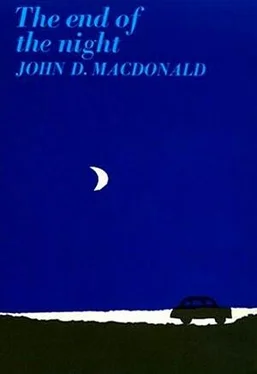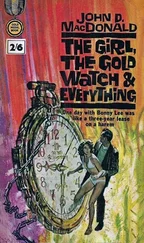She is five foot six and weighs a little over a hundred and twenty pounds. Her breasts are smaller than average, her hips rather wide and mature. She has a heavy, glossy mop of chestnut-brown hair, which she customarily wears completely unfettered. It falls below her shoulders. It is rather raggedly cropped in front, cut off at the level of her heavy eyebrows. She seems to look out from under it at you, like an animal safe under a hedge, watching you. Her eyes are a slightly muddy green, and very direct. While talking or listening she has a lot of tics and mannerisms that are all involved with the hair. She is forever fingering it, pulling a sheaf of it across her throat like a furry scarf, or pulling a strand of it across her lips, or across one eye.
Her other mannerisms, the way she sits and stands, are, I have been informed, a conscious imitation of that little French strumpet with the face like Huckleberry Finn. The French call such conscious imitation bardolatrie , I believe. Her features are quite plain, the nose snubbed and rather flat, the mouth broad and soft, the skin texture coarse, with the enlarged pores particularly evident on the broad cheekbones. Her only make-up is a dark lipstick, carelessly and lavishly used. On her brows and her strong hands are those small random scars acquired by those whose lives are spent close to the edge of darkness.
I find in reading over these paragraphs of description that I have not done her justice. The description itself is accurate, but in her case she adds up to more than the sum of the parts. There is a savage, sensuous impact to her appearance. Sander Golden has called her an animal. That word captures some of the essence of her. She exudes an automatic sexual challenge, a knowing, skeptical arrogance that makes a man feel there is something he should prove to her. I do not believe this is a conscious thing with her. It is, perhaps, a matter of glands, hormones. Even the slightly unwashed look of her constitutes, in itself, an inexplicable appeal — possibly an appeal to the base desires shared by all men, though acknowledged by very few of us.
I do know that it has been, and will continue to be, difficult to conduct interviews with her. When she has those direct green eyes on you and pulls that shining hair across her lips and slowly shifts her round, solid thighs, it is as if you are exploring two channels of communication simultaneously, only one of them verbal. And at times the subterranean communication becomes so strong as to drown out the words you are saying. And then, for a time, you are lost, and must pause and remember what you were trying to say.
Her background is drab. Her people are Polish peasants. They fled to West Germany in 1945 and were one of the fortunate families who spent very little time in a resettlement camp before coming to the United States with their three small children and settling near Bassett, Nebraska, in a tenant-farming situation. Nanette was six at that time. Three more children were born to the Koslovs in Nebraska. Nanette learned English rapidly, attended public school, and worked on the land. Her people were so strict as to border on cruelty. Nanette matured early. At fourteen, after being expelled from junior high school as a result of scandalous behavior involving some senior high school boys, she ran away with a migrant farm laborer who later abandoned her in San Francisco. Her family made no attempt to find her. She looked older than her years. Passing herself off as eighteen, she obtained work as a waitress. When she was sixteen she fell in with a bohemian group in that city. For the next three years she was a fixture in that curious subterranean artistic world of San Francisco which specializes in incomprehensible jazz, foolish painting and hysterical poetry, with their inevitable by-products of mysticism, coffee-house conversation, drug addiction, violence and self-pity. She worked sporadically and was passed back and forth from musician to painter to poet, as a model, an inspiration and a bedmate. During this period she learned the jargon of that milieu without the necessity of having to understand what she was saying — a condition shared, perhaps, by most of her associates.
Last year a painter with whom she was living was killed as a result of a violent argument during an impromptu party. Friends hid Nanette until it became certain the police wanted her for questioning. She fled to Los Angeles and became a member of a smaller group there. It was there she met Sander Golden. When a narcotics raid broke up the group, she left Los Angeles with Golden. Their tentative destination was New Orleans, where Golden had friends. They met Hernandez in Tucson, and the three of them traveled together as far as Del Rio, where Kirby Stassen joined the group.
It is difficult to assess the effect of Nan Koslov on the three men, insofar as their short career of extreme violence is concerned. Each member of the group had, I believe, a catalytic effect on the other three. In one sense perhaps the men felt a necessity to “show off” for the girl, to show her that they were beyond all rules and restrictions. But in order for her to achieve this effect upon them, it would first have been necessary for her to communicate to them her own taste for recklessness.
From the meager clues she has given me, I can perhaps reconstruct her attitude at Del Rio. Here was a girl who, for several years, had lived only for sensation. For kicks, as Sander Golden would say. Highly spiced foods deaden the palate. So ever-increasing quantities of spice must be used. It is the same with physical sensation. Though she denies it, there is, I believe, a good chance that she was directly involved in the killing of the artist in San Francisco. He was stabbed repeatedly in the abdomen with a long skewer used for fireplace cooking, and in the throat and in the nape of the neck with a table fork. There is such a flavor of primitive violence in this woman, of revolt against cruelties inflicted upon her, that she may have found a new and special pleasure in the act of killing. It is, one could say, the ultimate sensation, and she had been increasing the tempo of sensation over her short lifetime.
Also, Sander Golden had put her on his own routine of stimulants, a schedule which he had arrived at through trial and error and which he terms “The biggest thing since the wheel.”
It involved a carefully regulated intake of powerful tranquilizers, plus raw dexedrine and barbiturates.
As Nanette described it, “It was the most I’d seen. It kept you out there. Everything, every little thing, like a stone or a bottle, looked bright and important in a funny way, and you could laugh and understand things the squares couldn’t. He changed it a little for me, different from the way he took it, and kept asking me, and changing it, until he had it just right for me, and I could float all day and all night. But he couldn’t give much to Shack, because Shack went crazy. Sandy said he was going to patent it. You couldn’t get hooked on it. But sometimes my heart thumping would scare me a little. And anything you did — it didn’t seem to really count. Do you know what I mean? You could step off a building and laugh all the way down. We put Stass on it, and we both kept asking him, and Sandy kept changing it, but we never got it to him just right. We’d have him either all shaky and hopped, or falling asleep.”
So the regimen of the stimulants and depressants was another catalytic agent. It was a queasy rapture.
I must make one further point about Nanette Koslov which involves a reappraisal of my own thinking. It is a truism that men do not understand women. But until I met Nan Koslov, I had been content with one generalization which I felt fitted all women, from whore to princess. I had felt that women had a strong drive for stability and security. I believed it was a primitive heritage. They, I thought, were the undiluted conservatives in this world, the apostles of “things as they are.” They play safe. They do not gamble. They each want a safe nest somewhere in the world, and when they do not have it, they work and yearn for it.
Читать дальше







![Джон Макдональд - The Hunted [Short Story]](/books/433679/dzhon-makdonald-the-hunted-short-story-thumb.webp)


